- Quick Read
- Deep Read ( 6 Min. )

Why is Christian Science in our name?
Our name is about honesty. The Monitor is owned by The Christian Science Church, and we’ve always been transparent about that.
The Church publishes the Monitor because it sees good journalism as vital to progress in the world. Since 1908, we’ve aimed “to injure no man, but to bless all mankind,” as our founder, Mary Baker Eddy, put it.
Here, you’ll find award-winning journalism not driven by commercial influences – a news organization that takes seriously its mission to uplift the world by seeking solutions and finding reasons for credible hope.
Explore values journalism About usMonitor Daily Podcast
- Follow us:
- Apple Podcasts
- Spotify
- RSS Feed
- Download
TODAY’S INTRO
A Thanksgiving message from Abraham Lincoln
 Mark Sappenfield
Mark Sappenfield
Some of you will know of my friend, Duncan Newcomer, a Monitor reader and Lincoln scholar. I’ve mentioned him here before. In honor of Thanksgiving in the United States – a national holiday established by Abraham Lincoln – he sent me this poem made up of different Lincoln texts, perfectly calibrated for this moment in America and the world. I hope you enjoy.
So we must think anew,
And act anew.
We must disenthrall ourselves.
We are not enemies,
But friends.
We must not be enemies.
We cannot separate.
There is no line, straight or crooked,
Upon which to divide.
We cannot escape history.
No personal significance, or insignificance,
Can spare one or another of us.
The mystic chords of memory
Will yet swell the chorus of union
To every living heart
And hearthstone,
And again touch
The better angels of our nature.
Share this article
Link copied.

Help fund Monitor journalism for $11/ month
Already a subscriber? Login

Monitor journalism changes lives because we open that too-small box that most people think they live in. We believe news can and should expand a sense of identity and possibility beyond narrow conventional expectations.
Our work isn't possible without your support.
Hostage deal doesn’t erase Israeli view: War is only on pause
Wednesday saw the first major diplomatic breakthrough since the Israel-Hamas war began. Prisoners will be exchanged, and a four-day pause in the fighting will allow humanitarian aid into Gaza. But in Israel, there’s no sense that the end of the war is close.
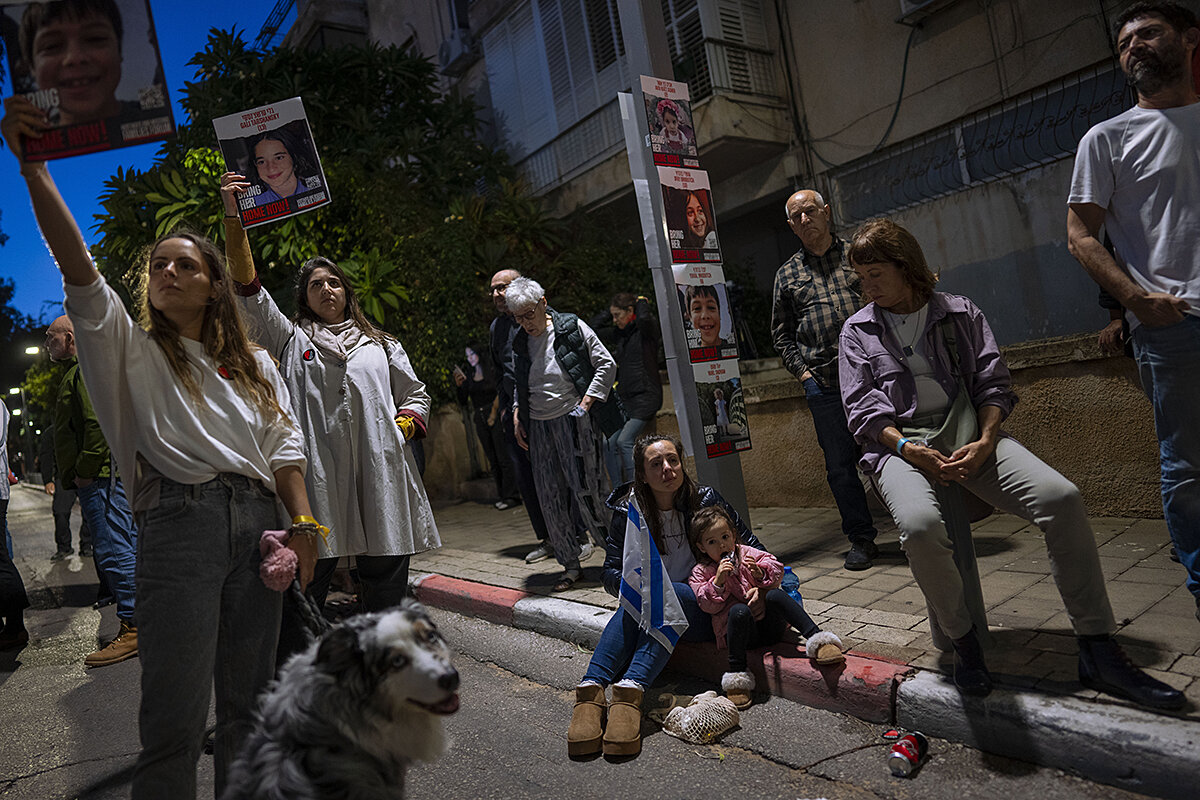
-
By Neri Zilber Contributor
It’s the most significant diplomatic breakthrough so far in a war that has lasted six weeks and left approximately 14,000 people dead in Gaza and Israel.
Israel and Hamas have agreed on a limited prisoner exchange, a truce for the time that it takes for the swap to happen, and an influx of humanitarian aid and fuel to hard-pressed residents of the Gaza Strip.
Hamas will not free all the 240 hostages whom Hamas fighters kidnapped Oct. 7 – just 50 women and children. But saving even a few dozen hostages is a “moral and ethical duty” in line with Jewish values, Israeli President Isaac Herzog said, which could be a “first step in returning all the hostages home.”
Israel will release 150 Palestinian women and minors held in its jails.
The deal offers only temporary respite for Gaza’s 2.3 million residents, half of whom have been forced to flee their homes by ferocious Israeli missile and artillery fire.
Once the prisoner releases end, “we will continue the war ... until we achieve all our objectives,” Israeli Prime Minister Benjamin Netanyahu told his government this week.
Hostage deal doesn’t erase Israeli view: War is only on pause
Streets, storefronts, and high-rises across Israel are dotted with their names and faces, along with the ubiquitous tagline, “Bring Them Home.”
Now, at least some of them – the nearly 240 men, women, and children abducted by Hamas in its devastating cross-border assault from Gaza Oct. 7 – may be coming home.
Early Wednesday, after hours of late-night deliberations, the Israeli government approved a deal brokered by Qatar, with input from the United States and Egypt, that would see Hamas release 50 Israeli hostages, all women and children, in return for a four-day “pause” in fighting.
In return, Israel committed to the release of 150 Palestinians – women and minors – being held in its prisons, and to facilitate entry into the battered Gaza Strip of significant amounts of humanitarian aid, including badly needed fuel.
The releases on both sides were set to be carried out in daily installments of some 10 to 12 Israelis and three times that number of Palestinians.
It is the most significant diplomatic breakthrough in a war that has lasted over 46 days, claiming the lives of more than 12,000 Palestinian residents of Gaza and at least 1,200 Israelis. More than 1 million Palestinians have been displaced from the north of the coastal enclave to the south, amid a ferocious Israeli ground invasion and relentless airstrikes that have reduced swaths of the territory to rubble.
According to the terms of the agreement, the option exists for an extension of the truce beyond the initial time frame, with Hamas committing to release 10 hostages for every additional day of nonbelligerence – but only up to 10 days in total. The Iran-backed Hezbollah militia in Lebanon is also expected to abide by the cessation in hostilities.
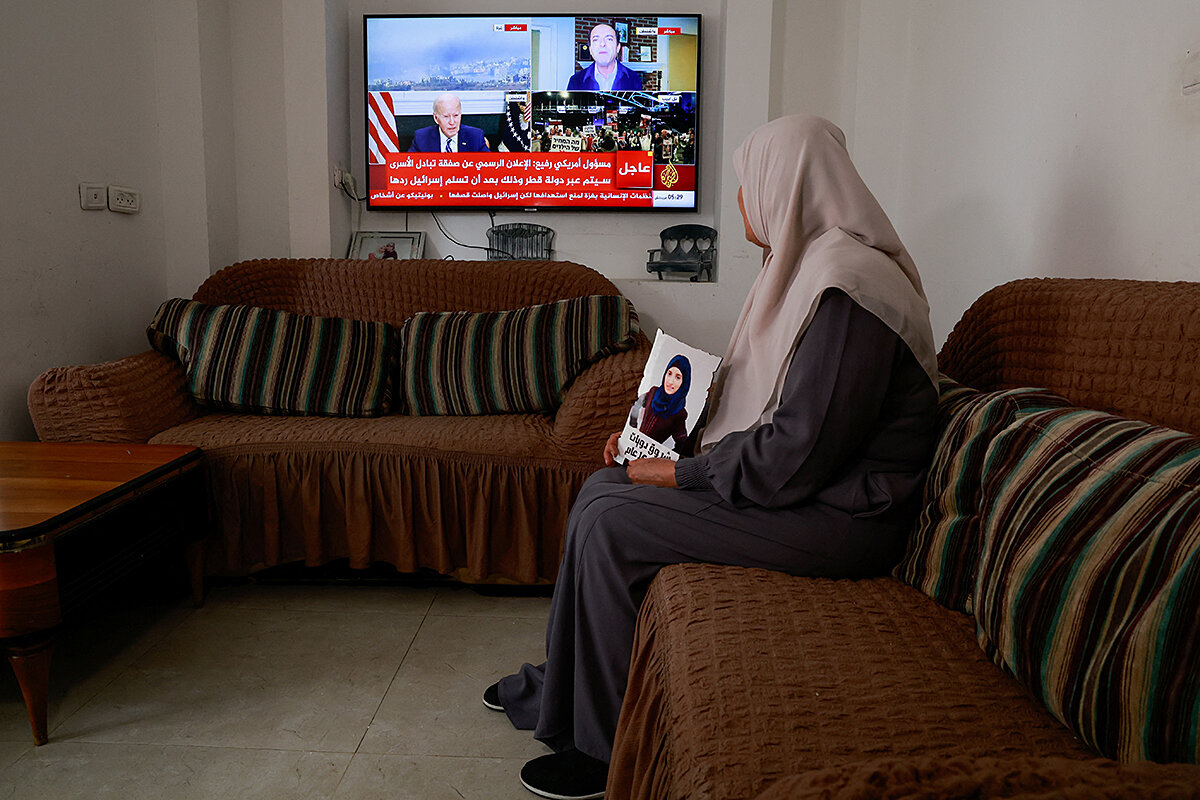
Despite the deal, implementation of which was set to start Thursday, mistrust between the two sides remains high. The chances are real for a violation and breakdown of the intricate terms agreed upon, analysts caution.
And Israeli officials made clear, even as they were approving its terms, that after the completion of the hostage release they would continue in their twin goals of the destruction of Hamas as a military and governing force in Gaza, and the safe return home of the remaining captives, including several dozen foreign nationals.
“We are at war, and we will continue the war ... until we achieve all our objectives: eliminate Hamas, return all our hostages and missing persons, and ensure that there will be no element in Gaza that threatens Israel,” Israeli Prime Minister Benjamin Netanyahu told his government late Tuesday night.
Internal opposition
The Israeli war cabinet conducting the campaign, along with the country’s security chiefs, had argued in favor of the deal – even at the risk of losing momentum on the battlefield and despite it being only a partial hostage deal.
Saving even a few dozen hostages, as Israeli President Isaac Herzog put it, is a “moral and ethical duty” in line with Jewish values that would hopefully be a “first step in returning all the hostages home.”
Yet several far-right ministers in the Netanyahu government voted against the deal, including National Security Minister Itamar Ben-Gvir of the Otzma Yehudit (Jewish Power) party. Mr. Ben-Gvir argued in a statement Wednesday that the Israeli military should have been ordered to keep up the “pressure” on Hamas.
“Precisely now it was forbidden to stop, and this is a historic mistake,” he wrote.
Military analysts and officials concede that Hamas will use the multiday pause to reorganize its fighters and rocket arsenal, which it has continued to fire throughout the war. As part of the deal, Israel committed to limit unmanned drone overflights above the territory.
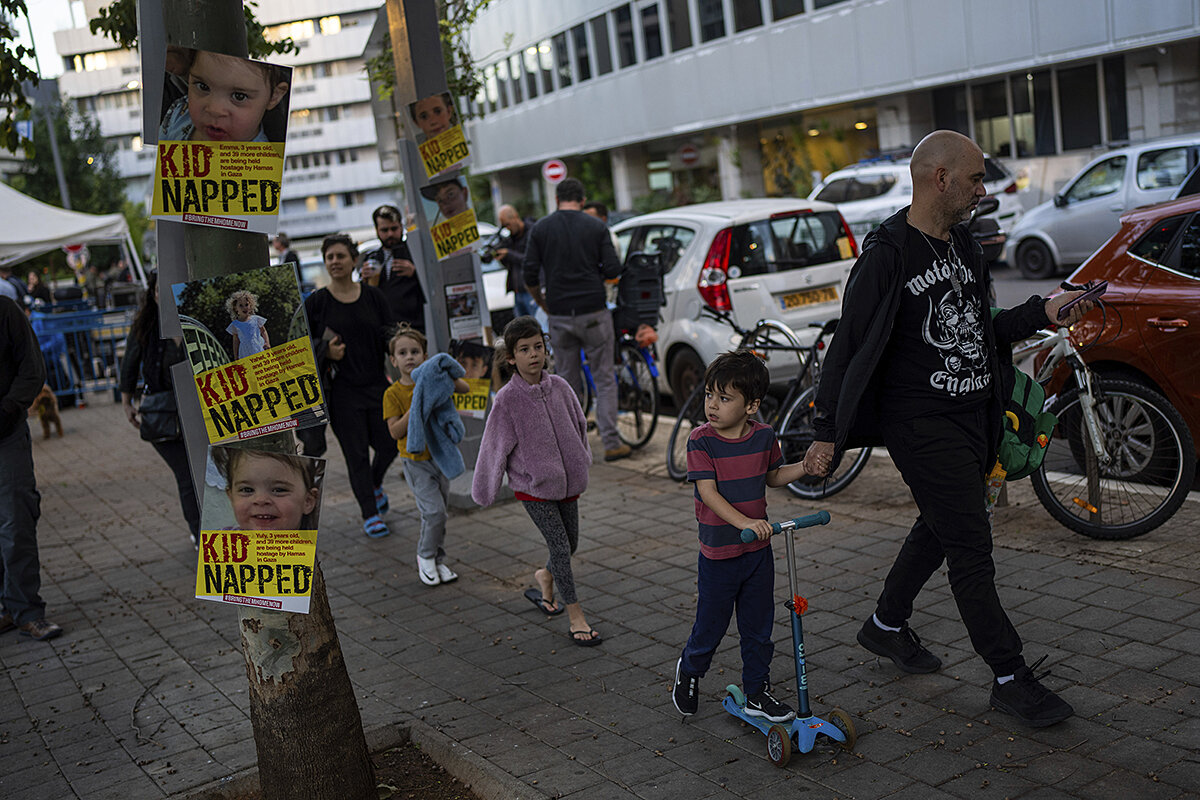
A halt to Israel’s relentless bombardment, in addition to the international aid effort, will likely be gratefully received by Gaza residents.
Hamas will undoubtedly portray the release of Palestinian prisoners as a major achievement. The group’s leader in Gaza, Yahya Sinwar, who is believed to be personally handling the hostage negotiations, was himself released in a prisoner exchange with Israel in 2011. He vowed to his fellow inmates back then that he would get them out, too.
In his only public comments since the start of the current war, Mr. Sinwar said last month he was “ready to conduct an immediate prisoner exchange deal,” under which all the Israeli hostages would be released in exchange for all Palestinian prisoners in Israeli prisons, estimated to be over 6,000 people.
War’s next phase
For now, the price Israel is paying for this initial deal is bearable, said retired Maj. Gen. Yaakov Amidror, a former Israeli national security adviser.
“We’re giving them [Hamas] more time to better prepare for the next stage of the war, I understand it,” he said. But it “won’t change the balance of power between Israel and Hamas.”
And the next stage of the war is coming, despite growing calls internationally for a full cease-fire.
The Israeli military will likely need a few more weeks to finish its high-intensity ground operations in north Gaza, several officials intimated. Then, the focus will likely shift to the southern region of the territory, which is where Hamas’ leaders and remaining rockets are believed to be located, along with the bulk of the Israeli hostages.
“A comprehensive military achievement will not be possible without addressing the south,” an Israeli official said last week.
Military objectives and international pressure aside, there is also domestic politics that will, Mr. Amidror argued, militate against any permanent halt to the war.
“It’s very clear to the decision-makers that they can’t stop. Israeli public opinion won’t let them stop. ... It’ll be the end of this government,” the retired general said. “The sentiment ... is so strong, to destroy Hamas [for the atrocities it committed Oct. 7], that they can’t stop” once the cease-fire ends.

For the relatives of those now being released, and the many others whose loved ones will remain in Gaza for the foreseeable future, such calculations are secondary.
“Securing the safe release of every hostage is a national priority. There is no victory until every last hostage returns home,” the Hostages and Missing Families Forum, the main group representing Israelis held captive in Gaza, said in a statement Wednesday.
Still “180 hostages left”
For Michael Levy, whose younger brother Or, 33, is one of those who will not be released yet, emotions are mixed.
On the one hand, “as a father myself,” says Mr. Levy, who met the pope in Rome Wednesday amid efforts to garner support for a hostage release, “I was happy to hear that children and women and families are set to be coming home.”
Yet on the other hand, the “mission,” as he calls it, was not yet complete.
“Do the math – there will still be 180 hostages left, and my brother is one of them,” he says. “Every person that gets released may improve the chances for my brother, since it may be the start of a comprehensive deal that gets everyone out.”
The Israeli government, he adds, cannot afford to have all these citizens languishing in captivity.
“I don’t care about the price, even if it’s ‘all [the Palestinian prisoners] for all [the Israeli hostages].’ They can destroy Hamas afterwards.”

What turmoil over a CEO tells us about the future of AI
There is much hand-wringing about artificial intelligence, and for good reason. Can we develop it responsibly, or will profits push scruples aside? OpenAI embodied an interesting approach to that question. The company’s descent into chaos this week points to the challenges ahead.

- Quick Read
- Deep Read ( 3 Min. )
If ever someone makes a movie about how not to fire a CEO, they could base their script on the playbook of OpenAI. On Friday, the San Francisco artificial intelligence company fired its chief executive, triggered a revolt from employees who threatened to leave, and early Wednesday announced a deal to reinstate him.
Because OpenAI owns ChatGPT, a leading AI language generator, or chatbot, all this got big attention. While the full details behind the firing of CEO Sam Altman are still not known, the turbulent events highlight wider societal questions over who will control this powerful transformative technology.
Will it be a few billionaire-owned corporations? A nonprofit consortium? The government through regulation?
OpenAI had tried a novel structure, as a nonprofit controlling a for-profit company – and with its board pledged to the mission of benefiting humanity. The upheaval at OpenAI represents, at least in part, an ongoing battle between the fear of AI’s potential dangers and the lure of its expected benefits and profits.
And the outcome there may signal the powerful role that capitalists and entrepreneurs will play in shaping AI’s future.
“Money wins a lot,” says Lilly Irani, a professor of communication at the University of California, San Diego.
What turmoil over a CEO tells us about the future of AI
If ever someone makes a movie about how not to fire a CEO, they could base their script on the playbook of OpenAI. On Friday, the San Francisco artificial intelligence company fired its chief executive, subsequently triggered a revolt from employees who threatened to leave, and, early Wednesday, announced it had reached an agreement to reinstate him.
Because OpenAI owns ChatGPT, a leading AI language generator, or chatbot, each of the company’s head-spinning moves got plenty of attention. While the full details behind the firing of CEO Sam Altman are still not known, the turbulent events highlight wider societal questions over who will control this powerful transformative technology.
Will it be a few billionaire-owned corporations? A nonprofit consortium? The government?
OpenAI had tried a novel structure, as a nonprofit controlling a for-profit company – and with its board pledged to the mission of benefiting humanity. The upheaval at OpenAI represents, at least in part, an ongoing battle between the fear of AI’s potential dangers and the lure of its expected benefits and profits.
The outcome, with Mr. Altman reinstated as CEO and new people on the company’s board, may signal the powerful role that capitalists and entrepreneurs will play – at least in the United States – in shaping the future of this emerging technology.
“This is an early skirmish in a war for the future,” says Tim O’Reilly, founder and CEO of O’Reilly Media and a visiting professor at University College London’s Institute for Innovation and Public Purpose.
AI sprang into the public consciousness almost exactly a year ago when OpenAI released ChatGPT to the public. It surpassed all expectations as an overnight sensation. People around the world couldn’t wait to interact with a super-knowledgeable computer that talked the way they did.
Less than two months later, OpenAI backer Microsoft announced it was plowing $10 billion into the company and would incorporate ChatGPT into its products. That set off a corporate spending race as Google, Amazon, and other tech giants sped up their own AI projects and investments. Capitalism was outrunning ethical concerns – again – in a period of disruptive technological change.
But this time it came with a twist. The companies themselves began raising the specter of super-intelligent machines causing harm if regulators didn’t provide guardrails.
In the rush for capital, OpenAI’s nonprofit structure came under pressure. The board came to feel it couldn’t trust Mr. Altman, a co-founder as well as CEO, who pushed for rapid development and deployment of AI, releasing the technology to the public. In his view, it was the best way to democratize the technology, expose its faults, and accelerate its benefits. His reinstatement and the overhauling of the board suggests that this techno-optimism has won out at OpenAI.
The ongoing struggle between techno-optimism and doomerism gets exaggerated in every period of rapid technological change, says Benjamin Breen, a historian at the University of California, Santa Cruz and author of an upcoming book on utopian science in the mid-20th century. No one knows where AI will take humanity. If history is any guide, he adds, the extremists on both sides tend to get it wrong.
For the foreseeable future, then, the battle over AI may not be whether the machines control people, but who and what controls the machines.
“Money wins a lot,” says Lilly Irani, a professor of communication at the University of California, San Diego. “Techno-optimism and techno-doomerism both miss the point about who has the voice at the table and gets to decide how the technology is designed, developed, and deployed.”

Podcast
Listen: The transformative power of giving thanks
The rest of today’s Daily focuses on the themes of this holiday weekend in the United States. First, one of our reporters went deep on gratitude last Thanksgiving with a story about letters of thanks, and then he joined our podcast to talk about it. For this holiday season, he’s back with a personal update after an illuminating year.

Do you keep an inventory of things for which you’re grateful?
Does gratitude make you feel girded against the world’s troubles? Has it made you more acutely aware of those who have less?
A year ago, the Monitor’s Harry Bruinius wrote about the power of gratitude, specifically about letters of thanks and the sense of connection and uplift they can inspire. He then joined our “Why We Wrote This” podcast to talk about giving thanks, and the ways in which that can boost well-being.
Harry returns to the show a year later to talk about the effects of that reporting on his own outlook. His beat can be a tough one. Harry reports on artistic censorship, curbs on free speech, religious persecution. Last summer he wrote about the fraying of community and connection.
His deep look at thanksgiving has been steadying in a turbulent world, Harry says in this updated episode.
“I absolutely think that a practice of gratitude, or a practice in which you really focus and meditate on the goodness that’s around you,” Harry says, “does provide [a] bulwark.” – Clayton Collins and Mackenzie Farkus
You can find story links and a transcript here.
One Reporter’s Guide to Gratitude

Book review
Hack your fridge: Delicious meals with less waste
Turkey leftovers aren’t the only food that gets thrown out. More than 125 billion pounds of uneaten food ends up in U.S. landfills each year. But these cookbook authors don’t just help readers eat well. They also help you reduce food waste in commonsense ways.

- Quick Read
- Deep Read ( 5 Min. )
Cookbook authors have a new reason to revive the old kitchen wisdom of “waste not, want not”: the future of the planet.
Eliminating food waste has become the latest culinary step in reducing emissions. This isn’t hyperbole. In the United States alone, 30% to 40% of the food supply is wasted each year, according to the U.S. Department of Agriculture.
That’s more than 125 billion pounds of food a year that goes uneaten, according to some estimates. Further, if waste ends up in plastic bags bound for the landfill, it could take decades to break down. The methane gas that builds up from such food waste contributes to rising global temperatures.
So what can a home cook do? This season’s roundup of cookbooks provides tips, encouragement, and tasty recipes to inspire new mindfulness in the kitchen.
Hack your fridge: Delicious meals with less waste

The old proverb “Waste not, want not” has renewed meaning and urgency in the kitchen, as more cookbook writers emphasize a key reason for reducing kitchen waste: the future of the planet.
Beyond eating local and in-season produce, eliminating food waste has become the latest culinary step in reducing emissions. This isn’t hyperbole. In the United States alone, 30% to 40% of the food supply is wasted each year, according to the U.S. Department of Agriculture. That’s more than 125 billion pounds of food a year that goes uneaten, according to some estimates. Further, if waste ends up in plastic bags bound for the landfill, it could take years to break down.
A head of lettuce in a garbage sack, for instance, could linger as a glob of slime through the time it takes a child to grow and graduate from college. The methane gas that builds up from such food waste contributes to rising global temperatures.
In October, government officials from 18 U.S. states urged the Environmental Protection Agency to phase out food waste disposal in landfills by 2040. At this year’s United Nations Climate Change Conference, which runs Nov. 30 through Dec. 12, food waste will be a priority.
So, what can a home cook do? This season’s roundup of cookbooks provides tips, encouragement, and tasty recipes to inspire new mindfulness in the kitchen.
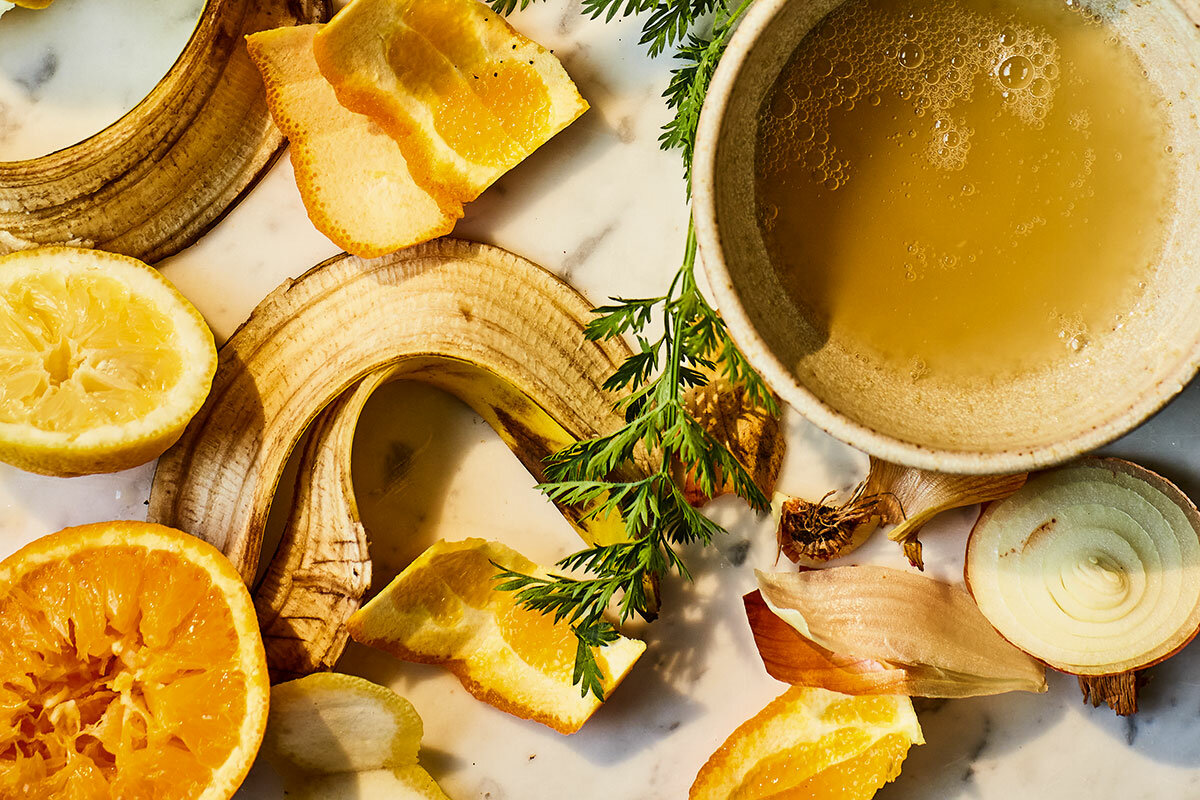
Hand-holding for newbies
Since commercial kitchens and restaurants are enormous contributors to food waste, one way to slow the tide of garbage is to cut back on dialing Uber Eats and start cooking at home. For beginner cooks, Jeremy Scheck offers simple dishes in “Cooking Smarter: Friendly Recipes With a Side of Science.” The author began cooking for himself in college on a shoestring budget. He first posted his recipes on a blog, but when he was sent home from school in March 2020, he switched to TikTok under the handle @scheckeats. And that’s where Scheck found an eager audience of people also stuck at home with nothing to do. His videos of simple roast potatoes garnered more than 20 million views.
“Cooking Smarter” is a carefully curated collection of his favorite recipes, with ideas for avoiding things like a cabinet full of one-use spices (read: waste). And that bottle of maple syrup isn’t just for pancakes; it’s also flavoring for salad dressing, a sweetener in muffins, and a glaze for roasted vegetables.
Scheck has your back, too. He provides guidelines to boost confidence in a short chapter, “Don’t Poison Yourself: Food Safety 101,” that includes tips for storing and freezing leftover food.
Another simple conservation step: Don’t bother to peel those carrots, apples, and potatoes. It may sound like basic advice, but that’s perfectly OK for newbie cooks who also like to scroll TikTok. Scheck’s humor will keep readers laughing as they, yes, cook smarter and learn the secrets to create mom’s roast chicken.
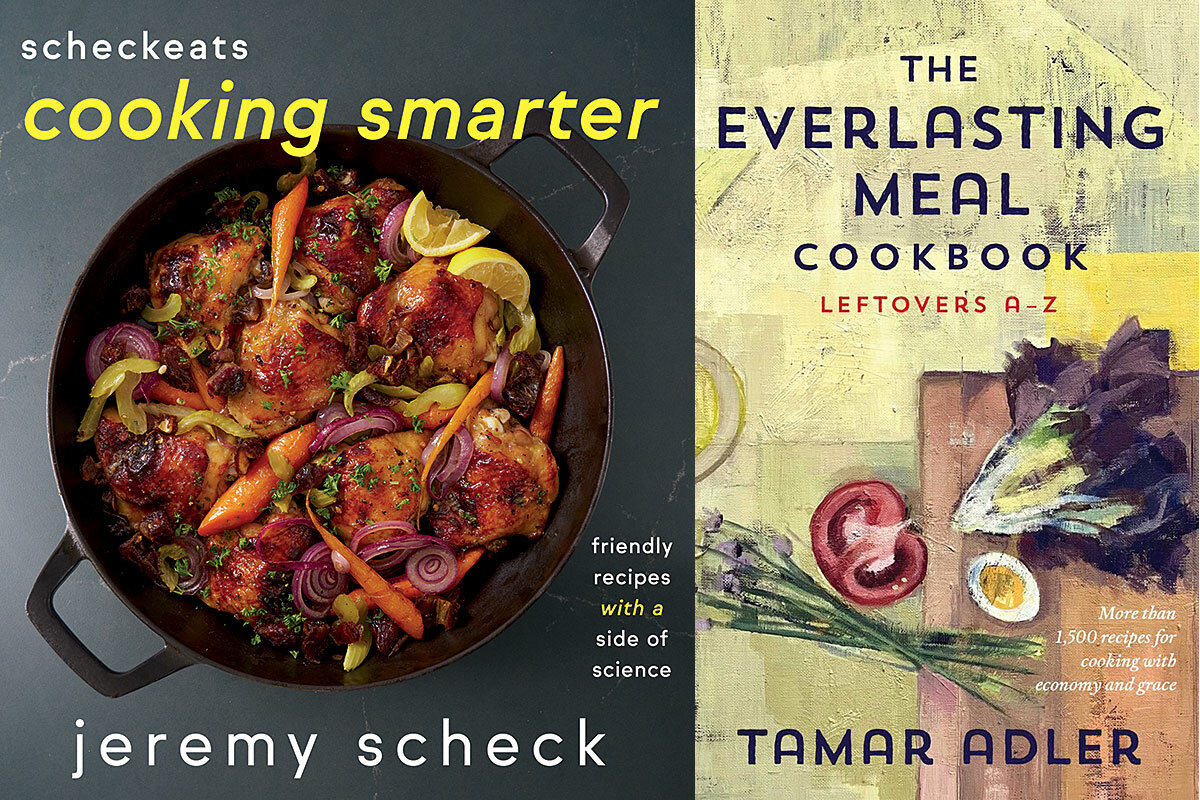
Fresh produce to the fore
Everyone has forgotten items lurking in the fridge and cupboards, and even if they aren’t filling landfills now, they soon will be. Max La Manna can help you change that with “You Can Cook This! Simple Everyday Recipes From What’s Left in Your Fridge.” He explains how to determine if your food is still safe to eat and how to save time and money by shopping in your own kitchen. But first, get organized. La Manna explains how to store perishable, semiperishable, and staple foods to maximize their shelf life. He advocates purging your fridge every two weeks, specifically those back corners. A diagram shows which shelves in your fridge should store leftovers (top shelf) and where to tuck butter and cheeses (top shelf of the door).
Since fresh foods are the quickest to turn bad, La Manna offers several helpful pages in the index for storing staples like potatoes, squash, leafy greens, herbs, fruit, and dairy. He also encourages using the whole vegetable, such as in pesto made from carrot tops, broccoli stems, or other wilting greens.
His recipes will satisfy more adventurous eaters while also pleasing the eye. An example is the colorful ribbons of carrots and beets bathed in a tahini balsamic vinaigrette. La Manna, who has a strong social media presence, folds in analytics to endorse his recipes. Would you believe 4 million viewers? Then check out his crowd-pleasing tofu butter “chicken” recipe.

Chinese American fusion
Reduced waste is good, but no waste is better. Boston sisters and business partners Margaret Li and Irene Li level things up in “Perfectly Good Food: A Totally Achievable Zero Waste Approach to Home Cooking.” That’s right, zero waste.
Before you think that means eating garbage, the Li sisters will demonstrate the joy to be found in running a kitchen so efficiently your fridge will hum with happiness. The award-winning Lis have operated food trucks and restaurants, and written cookbooks all with an eye toward a more sustainable food system. This cookbook, designed to teach and entertain the home cook, is based on their website “Food Waste Feast.” It’s written in a voice that sounds like your bestie and is brought to life with illustrations by Iris Gottlieb, which add humor and color.
A few tips that will change your kitchen life: create an “eat me first” box in your fridge to keep the most perishable ingredients front and center, view expiration dates with an open mind, learn how to compost like a champ, and understand the difference between the vegetable crisper and fruit crisper.
“Hero recipes” in the vegetable and fruit section emphasize flexibility and creativity while avoiding additional trips to the grocery store.
The Lis are wizards of Chinese American fusion food, so it’s no surprise that pickling, stir-frying, and Asian-inspired recipes are recurring themes. With so much good information and recipes to absorb in this cookbook, you will turn to it again and again.
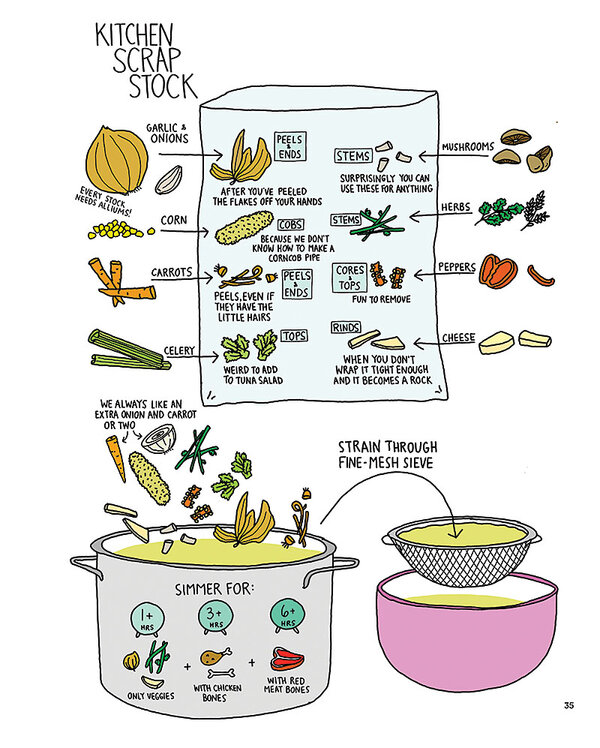
Tasty and artful leftovers
Even experienced cooks will find something to learn from Tamar Adler’s “The Everlasting Meal Cookbook: Leftovers A-Z.” This should join the reference shelf in your kitchen as a comprehensive guide to assembling any mismatched array of food into something artful and memorable.
Adler, who has an impressive résumé of cooking in the kitchens of Prune and Chez Panisse in addition to being an accomplished food writer, has captured her kitchen wisdom in more than 1,500 recipes.
The book is helpfully organized into sections on vegetables, fruits and nuts, seafood, and dough and noodles. So you’ll know exactly where to turn for a recipe that uses wilted radicchio, for example. In this case, sauté the radicchio with olive oil, garlic, and beans, then top with fresh herbs and grated Parmesan cheese.
Ponder her lyrical musings while you breathe in the steam of savory stock broth as it simmers. In the introduction to the section on meat and tofu, she writes, “If we each bowed sometimes, in sight of our children, before ingredients as humble as animals’ feet, it might teach useful lessons about how to treat our fellow beings.”
Despite her culinary pedigree, Adler hangs her oven mitts in a typical home kitchen. In the snacks section, you’ll find uses for stale cereal and snacks, such as the Fried Rice Cheeto Salad (yes, you read that right). Under “Oreos, stale,” Adler states simply, “Let’s be honest. Oreos are good stale.”

‘A ray of light’: How I found gratitude in trying times
In tough times, being grateful can feel difficult, even a forced form of “suffocating optimism.” But this writer went deeper. In seeking something more active than counting blessings, she found awe and appreciation – even transformation – in her connection with others.
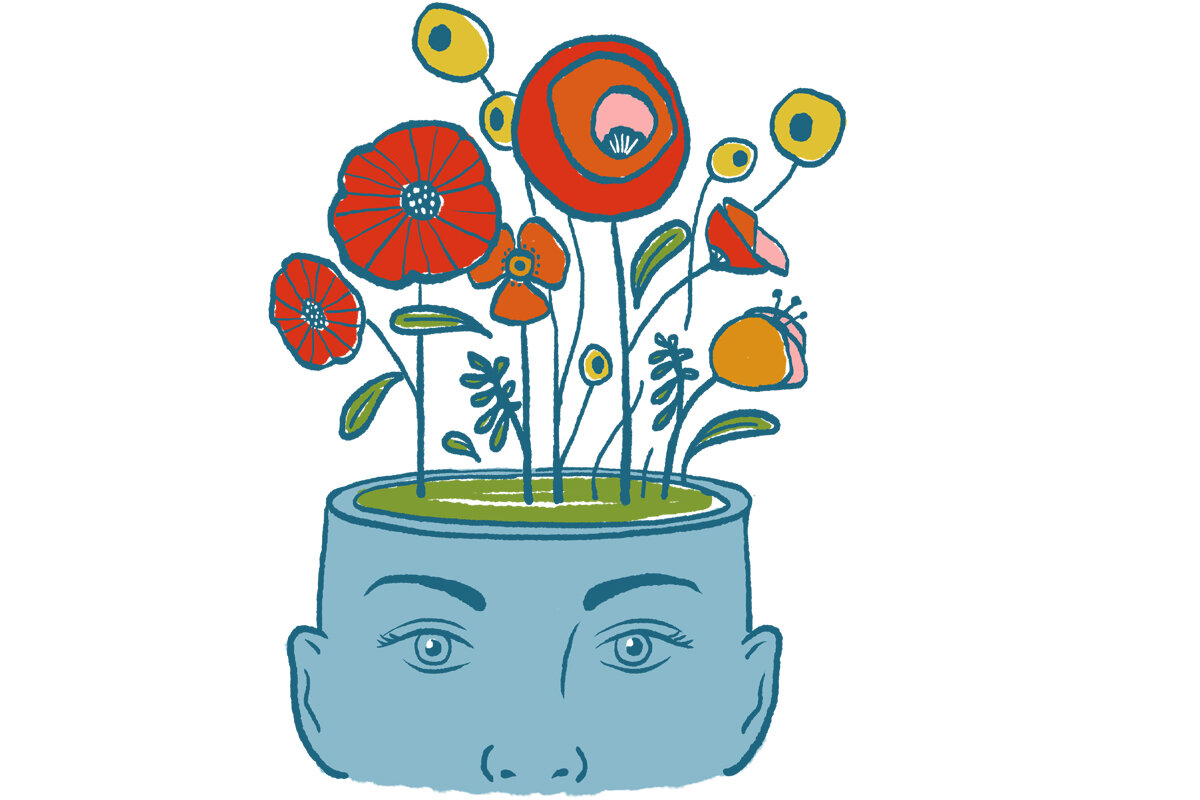
- Quick Read
- Deep Read ( 5 Min. )
-
By Samantha Laine Perfas Contributor
I should be grateful. The thought floats through my mind as I stare outside on the cloudy fall day. All of my basic needs are met, and there is so much good in my life. Why can I not muster the energy to feel grateful?
Many of us have tried gratitude lists and journals, affirmations and the counting of our blessings.
When we use gratitude to make ourselves feel better, it’s a bit “flimsier” or self-serving. When we practice it as a moral obligation, we shift our attention to others, says Chaim Steinmetz, a New York rabbi. This can be transformative.
I was doing gratitude wrong. Yes, it’s possible to find gratitude in my morning cup of coffee, but it is so much more powerful to find it in my connection to others. To see and be seen authentically is when I’m reminded how much I need the people in my life. There’s an immenseness to this, a deep sense of awe.
“When things are difficult, finding the ability to look for that one good thing is actually heroic,” Rabbi Steinmetz says. “Gratitude is the resolution that life is worth living ... a ray of light that reminds [us] why life is important.”
‘A ray of light’: How I found gratitude in trying times
I should be grateful.
The thought floats through my mind as I stare outside on the cloudy fall day. Next to me, steam curls in elegant wisps from my coffee cup. The baby monitor shows a peaceful toddler, gently stirring from his slumber.
There’s no immediate reason to feel anything but gratitude. All of my basic needs are met, and there is so much good in my life. Yet, sitting in the calm before the day begins, I try to summon the fuzzy feelings of thankfulness.
I feel a bit empty. Confused, even. Why, as I look around and count my blessings, can I not muster the energy to feel grateful?
“We’re making the argument that we kind of do gratitude wrong,” Jenae Nelson says when I give her a call. Many people look for answers to why they don’t feel more grateful, she added. We’re often told to create a gratitude list or keep a journal that documents our thanks, says Dr. Nelson, a psychologist who researches gratitude. Research has shown those things are helpful, but they only get you so far.
“Traditional gratitude lists are really good for helping us acknowledge our blessings,” says Dr. Nelson. This is a good first step, she continues, “but the problem is, if you get stuck there, then they stop working after a while.”
That’s where I am. Despite listing the blessings in my life, I can’t shake the bleak reality: I don’t feel grateful. That realization brings with it a different set of emotions: guilt, mostly. In these moments, trying to be grateful actually feels, well, terrible.
“Sometimes it can backfire, the idea of being grateful,” A. Helwa tells me when I speak with her. “Because it can introduce shame.”
Ms. Helwa, author of “Secrets of Divine Love: A Spiritual Journey Into the Heart of Islam,” shared that in her faith, gratitude is less about material belongings and more about an internal practice. Gratitude, or shukr, transcends one’s circumstances. It’s not necessarily an emotion or reaction to something gained, but more a state of being, “of mind and heart.”
Of course, true gratitude must be authentic. However, it can be difficult to express genuine gratitude when our feelings are hidden behind forced smiles and empty words of thanks.
“We do live in a culture of suffocating optimism,” Chaim Steinmetz, the senior rabbi of Congregation Kehilath Jeshurun in New York, told me. He’s written about gratitude and how it’s practiced in the Jewish faith. “[People] don’t understand that it’s more important ... to live a life of meaning and authenticity than a life of happiness.”
I wanted to challenge my own pursuit of “suffocating optimism,” as Rabbi Steinmetz put it. On a particularly hard day, I was struggling to stay positive. My husband came into the room, and I decided to drop the facade and be honest: I was struggling.
As we embraced, he admitted that he was struggling, too. He shared that when he had recently driven through our old neighborhood, he’d been hit by waves of nostalgia, longing, feeling acutely that the place we had left had been our true home. Our new community? We were still finding our footing.
Soon, we were both crying, reflecting on all the things we had loved: going for long hikes in the woods, the plethora of playgrounds, watching our son learn to walk in the local library. All of these things had been filled with such joy, so many memories.
As our tears began to dry, I sniffled. “But you know what?” I asked. “When we lived there, we didn’t appreciate any of those things.” My husband agreed. We didn’t realize what a blessing it was until it was gone.
Something that Ms. Helwa said resurfaced in my mind: the Islamic concept of kashf, or unveiling. Gratitude is simply unveiling the beauty that is inherent to everything. How do we peel back the layers of our own perceptions – riddled with trauma, insecurities, criticism – to see the good that is there?
For Ms. Helwa, the moments when we struggle the most are the most powerful times to turn to God or those around us. Rather than hiding, sometimes the best thing we can do is offer empty hands and an ungrateful heart.
“I’m bringing that lack of gratitude to You because I know that You are capable of unveiling something,” she says, referring to her own relationship with God. “I’m not grateful. But I come to You with the hope of being grateful.”
Gratitude can help our psychological well-being but it is also an ethical imperative, Rabbi Steinmetz explains. When we use gratitude to make ourselves feel better, it’s a bit “flimsier” or self-serving. When we practice it as a moral obligation, we shift our attention to others. This can be transformative.
“It’s a completely different way of seeing the world,” Rabbi Steinmetz says. In Hebrew, the word hoda’ah is used both “to offer thanks” and to concede to another. It is a word for both appreciation and surrender.
“When you truly offer gratitude to another person, you are essentially saying, ‘I can’t do it myself,’” he says.
Dr. Nelson recently published a paper in The Journal of Positive Psychology that looks at the connection between gratitude and indebtedness. Negative indebtedness is the feeling of obligation to return the favor, to pay a debt. That type of indebtedness can be harmful to relationships. When we feel forced to do good, it takes away our agency and becomes “stifling,” she says.
Positive indebtedness, on the other hand, is an internal motivation to pay it forward or do good in the world. Many experience this deep sense of indebtedness in their spiritual practices, or when they consider how much their parents loved and cared for them. Researchers found that gratitude and positive indebtedness are highly connected, and that feeling indebted to another can deepen your relationship.
“Positive indebtedness: that is what builds relationships and binds you together with that person,” Dr. Nelson says.
As my husband and I stood in the kitchen, holding each other and crying, I felt it: that warm, fuzzy glow of gratitude. Gratitude for my husband, expressing his complicated feelings. Gratitude that we were able to be vulnerable with one another. Gratitude that I could lean on him when I was struggling, and he on me.
I was doing gratitude wrong. Yes, it’s possible to find gratitude in my morning cup of coffee, but it is so much more powerful to find it in my connection to others. To see and be seen authentically is when I’m reminded how much I need the people in my life. And they need me, too. There’s an immenseness to this, a deep sense of awe. And when I don’t feel particularly grateful, I can ground myself in that truth.
“When things are difficult, finding the ability to look for that one good thing is actually heroic,” Rabbi Steinmetz says. “Gratitude is the resolution that life is worth living ... a ray of light that reminds [us] why life is important.”
Other headline stories we’re watching
(Get live updates throughout the day.)The Monitor's View
Thanksgiving unity during a divisive war
- Quick Read
- Deep Read ( 2 Min. )
-
By the Monitor's Editorial Board
When wars break out, it is natural to care for the innocent people put in harm’s way. Such caring has risen dramatically during the war between Israel and Hamas in Gaza. Some favor concern for Israelis, others for Palestinians. Yet others reach for a higher practice of care, rooted in religious faith.
At a church in Palo Alto, California, for example, local rabbis, imams, and clergy from other religious traditions gathered Nov. 11 for a prayer vigil in response to the war, but aimed at healing divides in their own community. “We’ve grieved together, we’ve wondered what we might bear witness to during this very difficult time,” said the Rev. Eileen Altman, associate pastor at the city’s First Congregational Church.
“Even if we don’t quite know what to say yet, we know we want to pray together for peace. We want to sing together, we want to pray together. We want to be together.”
That solemn unity and praise is at the heart of the Thanksgiving holiday in the United States. In times of peace and prosperity, Americans gather to share gratitude for the blessings in their lives. During times of war, the occasion carries an even deeper resonance.
Thanksgiving unity during a divisive war

When wars break out in distant lands, it is natural to care for the innocent people put in harm’s way. Such caring has risen dramatically during the war between Israel and Hamas in Gaza. Some favor concern for Israelis, others for Palestinians. Yet others reach for a higher practice of care, rooted in the tenets of religious faith.
At a church in Palo Alto, California, for example, local rabbis, imams, and clergy from other religious traditions gathered Nov. 11 for a prayer vigil in response to the war, but aimed at healing divides in their own community. “We’ve grieved together, we’ve wondered what we might bear witness to during this very difficult time,” the Rev. Eileen Altman, associate pastor at the city’s First Congregational Church, told the Palo Alto Weekly.
“We felt like, even if we don’t quite know what to say yet, we know we want to pray together for peace. We want to sing together, we want to pray together. We want to be together.”
That solemn unity and praise is at the heart of the Thanksgiving holiday in the United States. In times of peace and prosperity, Americans gather to share gratitude for the blessings in their lives. During times of war, the occasion carries an even deeper resonance.
In 1863, during the American Civil War, President Abraham Lincoln proclaimed the first national Day of Thanksgiving and Praise. In the midst of a conflict “of unequalled magnitude and severity,” he implored Americans to “solemnly, reverently and gratefully” acknowledge God’s mercy “with one heart and one voice.” Marking Thanksgiving in 1940, before the United States had entered World War II, first lady Eleanor Roosevelt urged an obligation toward “our fellow human beings – people ... whom we could love and understand if it were not for this thing called war.”
At the turn of the 20th century, Mary Baker Eddy, who founded Christian Science and this newspaper, wrote in The Boston Globe that Thanksgiving “signifies that love, unselfed, knocks more loudly than ever before at the heart of humanity and that it finds admittance.”
One reason for the prayer vigil in Palo Alto was to open doors between strangers in the community. “How do we love our neighbors if we don’t even know them?” asked Samina Sundas, a Muslim civil rights advocate and an organizer of the event. “So my request to my fellow Americans would be: Please get to know your neighbors. ... Because the only way this can subside – this war and violence – is if we see each other and see our humanity,” she said, according to the Palo Alto Weekly.
That kind of selfless love needs no special day for gratitude. In seasons of war, it is especially needed to express moments of union that can help open windows for peace.

A Christian Science Perspective
Each weekday, the Monitor includes one clearly labeled religious article offering spiritual insight on contemporary issues, including the news. The publication – in its various forms – is produced for anyone who cares about the progress of the human endeavor around the world and seeks news reported with compassion, intelligence, and an essentially constructive lens. For many, that caring has religious roots. For many, it does not. The Monitor has always embraced both audiences. The Monitor is owned by a church – The First Church of Christ, Scientist, in Boston – whose founder was concerned with both the state of the world and the quality of available news.
God’s gift of love
- Quick Read
- Read or Listen ( 1 Min. )
It’s natural for a song of praise to rise up as we witness how abundantly God bestows goodness upon His spiritual creation.
God’s gift of love

Ask, and it shall be given you; seek, and ye shall find; knock, and it shall be opened unto you.
– Matthew 7:7
In divine Science, where prayers are mental, all may avail themselves of God as “a very present help in trouble.” Love is impartial and universal in its adaptation and bestowals. It is the open fount which cries, “Ho, every one that thirsteth, come ye to the waters.”
– Mary Baker Eddy, “Science and Health with Key to the Scriptures,” pp. 12-13
To God then praises let us sing
With glad and willing mind
For all the gifts His hand doth bring
To us and all mankind:
Forever doth His gift of love
Pour warmth and radiance from above.
– Robert Ellis Key, “Christian Science Hymnal,” No. 311, © CSBD

Viewfinder
Talking trash

A look ahead
Thank you for joining us today. As you might have noticed, tomorrow begins the Thanksgiving holiday weekend in the United States. And I can attest that Black Friday has made it to Europe, too. (They call it Black Week – in English, curiously – here in Germany.) With all that turkey-eating and deal-shopping, the next issue of The Christian Science Monitor Daily will come to you on Monday, Nov. 27.
You can look forward to more on the situation in the Middle East, the legal defense taking shape around former President Donald Trump, and the next installment in our Climate Generation series. We’ll see you then!


